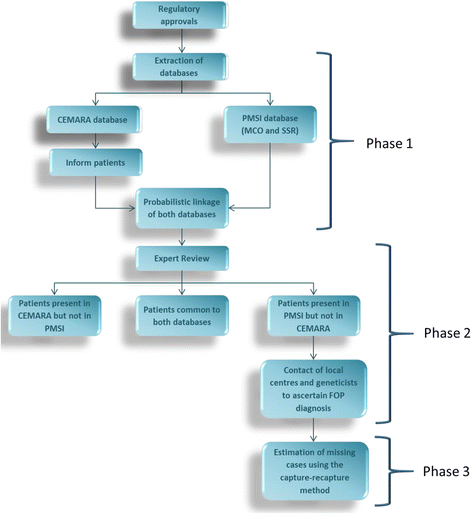Prevalence of fibrodysplasia ossificans progressiva (FOP) in France: an estimate based on a record linkage of two national databases
- PMID: 28666455
- PMCID: PMC5493013
- DOI: 10.1186/s13023-017-0674-5
Prevalence of fibrodysplasia ossificans progressiva (FOP) in France: an estimate based on a record linkage of two national databases
Abstract
Background: Fibrodysplasia ossificans progressiva (FOP) is a rare, severely disabling, and life-shortening genetic disorder that causes the formation of heterotopic bone within soft connective tissue. Previous studies found that the FOP prevalence was about one in every two million lives. The aim of this study is to estimate the FOP prevalence in France by probabilistic record-linkage of 2 national databases: 1) the PMSI (Programme de médicalisation des systèmes d'information), an administrative database that records all hospitalization activities in France and 2) CEMARA, a registry database developed by the French Centres of Reference for Rare Diseases.
Results: Using a capture-recapture methodology to adjust the crude number of patients identified in both data sources, 89 FOP patients were identified, which results in a prevalence of 1.36 per million inhabitants (CI95% = [1.10; 1.68]). FOP patients' mean age was 25 years, only 14.9% were above 40 years, and 53% of them were males. The first symptoms - beside toe malformations- occurred after birth for 97.3% of them. Mean age at identified symptoms was 7 years and above 18 years for only 6.9% of patients. Mean age at diagnosis was 10 years, and above 18 years for 14.9% of the patients. FOP patients were distributed across France.
Conclusions: Despite the challenge of ascertaining patients with rare diseases, we report a much higher prevalence of FOP in France than in previous studies elsewhere. We suggest that efforts to identify patients and confirm the diagnosis of FOP should be reinforced and extended at both national and European level.
Keywords: Data bases; Epidemiology; Fibrodysplasia ossificans progressiva; Prevalence; Rare genetic diseases.
Figures
References
-
- Shore EM, Xu M, Feldman GJ, Fenstermacher DA, Cho TJ, Choi IH, et al. A recurrent mutation in the BMP type I receptor ACVR1 causes inherited and sporadic fibrodysplasia ossificans progressiva. Nat Genet. 2006;38(5):525–7. - PubMed
Publication types
MeSH terms
LinkOut - more resources
Full Text Sources
Other Literature Sources



